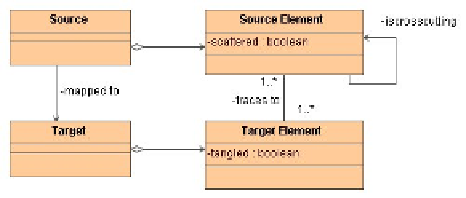Information Technology Reference
In-Depth Information
s1
s1
s2
s2
s3
s3
source
source
target
target
t1
t1
t3
t3
t2
t2
t4
t4
Fig. 1.
Trace relations between source and target elements
intuitive notions of crosscutting, scattering and tangling which we can find in the
literature such as “
an aspect in requirements is a concern that crosscuts requirements
artifacts; an aspect in architecture is a concern that crosscuts architectural artifacts”
[6] or
“scattering occurs when the design of a single requirement is necessarily
scattered across multiple classes and operations in the object-oriented design”
,
“tangling occurs when a single class or operation in the object-oriented design
contains design details of multiple requirements”
both in [5]. As we can see in these
citations, the notion of crosscutting, scattering and tangling is based on the
relationship of elements at two levels or domains, depicted here as source and target.
We discuss this in Sect. 6.
In the following section we generalize this intuition by means of a crosscutting
pattern. Furthermore, we focus on definitions of crosscutting, tangling and scattering.
2.1 Generalization
Our proposition is that crosscutting can only be defined in terms of “
one thing” with
respect to "another thing”
. Accordingly and from a mathematical point of view, what
this means is that we have two domains related to each other through a mapping. We
use here the general terms
source
and
target
(as in [24]) to denote these two domains,
and the trace relationship is the mapping relating elements in these domains (see Fig. 2).
Fig. 2.
Crosscutting pattern
We use the term
Crosscutting Pattern
to denote the situation where source and
target are related to each other through trace dependencies. We use the term
pattern
as
in design patterns [18], in the sense of being a general description of frequently
encountered situations [23,25].





Search WWH ::

Custom Search